Research
Simulating the Universe to answer unobservable questions about the evolution of galaxies captures my research interests most accurately. Be it developing models and analysis techniques to run and analyze cosmological simulations or testing specific phenomena using idealized simulations, I see computational astrophysics as a vital pathway for deepening our understanding of the Universe.
In my current research, I developed analysis methods and pipelines for conducting novel analyses on state-of-the-art cosmological simulations.
Dynamics of multiphase CGM around massive galaxies in the ROMULUS simulations
In this project, I use high-resolution Romulus Cosmological simulation to explore the origin and evolution of circumgalactic medium (CGM) in the range $ 0.1 < R/R_{500} < 1$ around massive central galaxies ($M_* > 10^{11} M_\odot$) in group scale halos. We find that the CGM is both multiphase and highly dynamic. By conducting a thorough and detailed novel analysis of its dynamic we identified seven patterns of evolution, two of which are the ways that gas cools. The gas cools via (1) filamentary cooling inflows and (2) condensations forming from rapidly cooling density perturbations. In our cosmological simulations, the perturbations are mainly seeded by orbiting substructures, in comparison with idealized simulations where they show that perturbations are seeded only by turbulence triggered by Active galactic nuclei (AGN) jet outbursts. Our findings show that the condensations can form even when the median $t_\mathrm{cool} / t_\mathrm{ff}$ of the X-ray emitting gas is above 10 or 20. which is a threshold for thermal instability set by observations for the global value of $t_\mathrm{cool} / t_\mathrm{ff}$. Strong amplitude perturbations can provoke runaway cooling regardless of the state of the background gas. We also find perturbations whose local $t_\mathrm{cool} / t_\mathrm{ff}$ ratios drop below the threshold but which do not condense. Rather, the ratios fall to some minimum value and then bounce. These are weak perturbations that are temporarily swept up in satellite wakes and carried to larger radii. Their $t_\mathrm{cool} / t_\mathrm{ff}$ ratios decrease because $t_\mathrm{ff}$ is increasing, not because $t_\mathrm{cool}$ is decreasing. For structures forming hierarchically, this study highlights the challenge of using a simple threshold argument to infer the CGM's evolution. It also highlights that the median hot gas properties are suboptimal determinants of the CGM's state and dynamics. Realistic CGM models must take into account the effects and after-effects of mergers and orbiting satellites, along with the CGM's heating and cooling cycles.
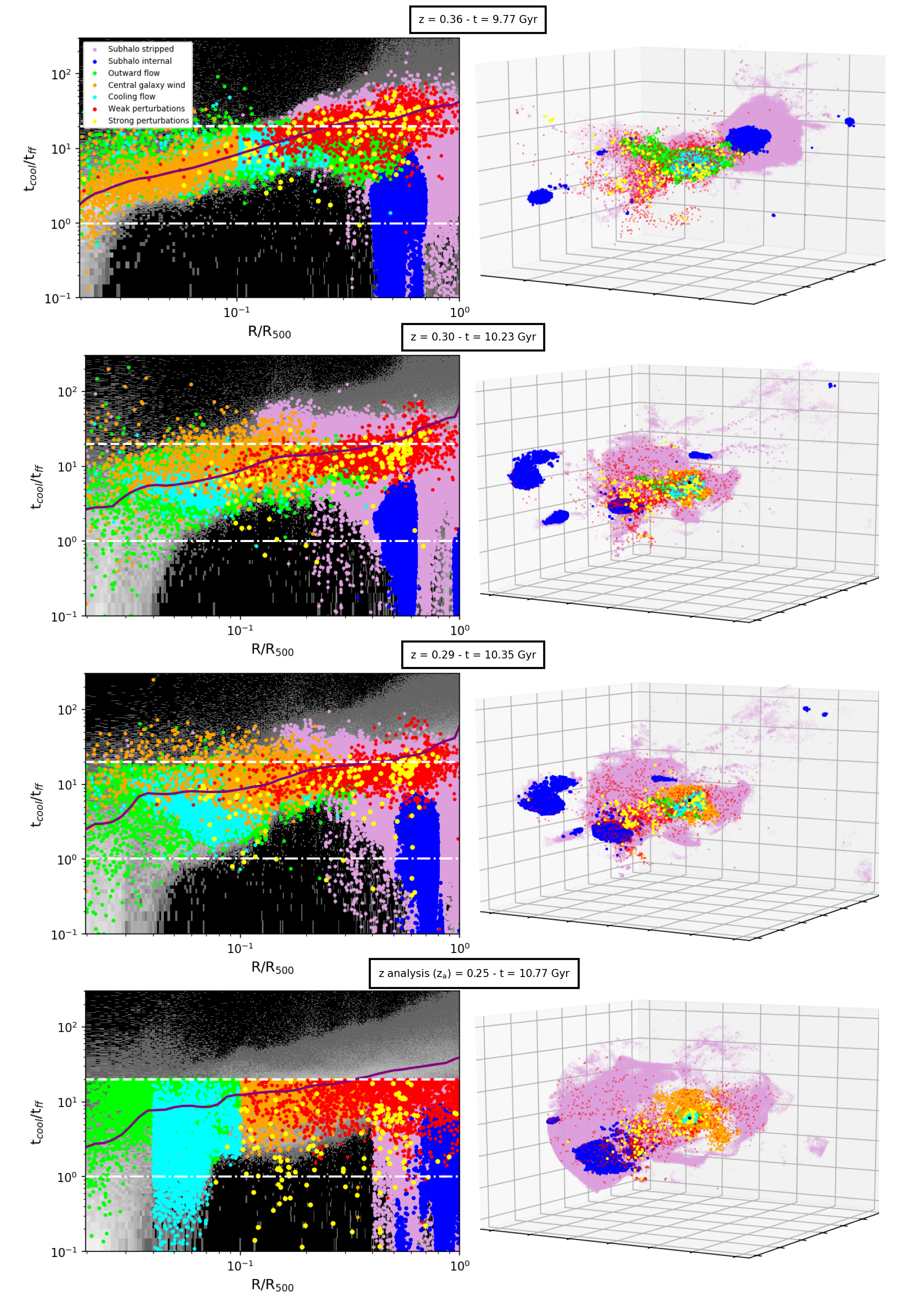
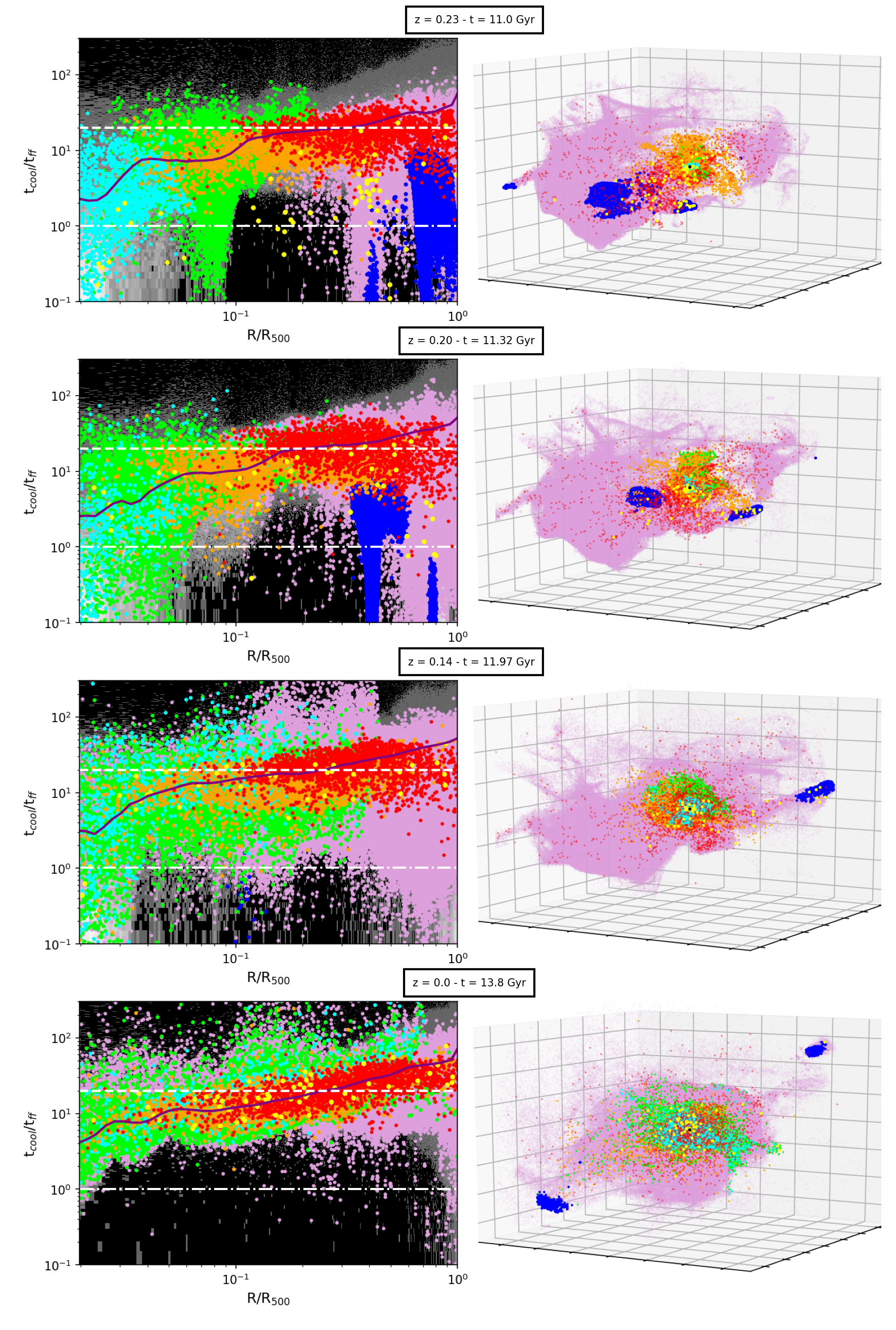
The ``condensation-susceptible'' CGM (defined as CGM gas with $t_cool{ff}/t_{ff} < 20$) at $z_\mathrm{a}$ comprises seven sub-components whose evolution is discernibly different. Here, we use {\sc Romulus} G1 group to illustrate how these sub-components evolve. At $z_\mathrm{a}$, we sub-sample gas associated with each sub-component; plot them in different colors (see legend) and follow this gas backward and forward in time. The first three rows in the left figure show the state of the sub-components at three earlier epochs. and the four rows in the right figure show at epochs after $z_\mathrm{a}$. In each figure, the left column shows the gas in the $t_\mathrm{cool} / t_\mathrm{ff}$ vs.~radius plane; the right columns show its 3D spatial distribution.
Dual AGNs: Detecting bright AGN pairs onto the path to binary black holes and black hole mergers
Merging and orbiting satellite galaxies not only perturb the CGM but also bring with them supermassive black holes (SMBHs) that reside in their center. The rich merger history of massive galaxies essentially means that SMBH-SMBH mergers are ubiquitous over cosmic time. The path from galaxy-galaxy mergers to the eventual SMBH-SMBH mergers involves a sequence of processes spanning a large dynamic range of spatial scales. In some cases, two BHs will pass through a phase where both are accreting and radiating efficiently, thereby appearing as close pairs of luminous AGNs. Dual AGN events can be used to study accretion on SMBHs and SMBH-SMBH mergers. This brings me to my next project, where I use Romulus cosmological hydrodynamic simulation to explore the properties of dual AGNs. Romulus is uniquely suited to study SMBH-SMBH interactions because it uses a novel sub-grid prescription to follow the orbital dynamics of the SMBHs. I investigate properties of dual AGNs with separation $<$ 30 kpc in two groups of luminosity criteria ($L_{HXR} > 10^{42}$ erg/s and L $>$ JWST detectibility luminosity at z ). I analyze the population demographics and statistics of dual AGNs occurring over cosmic time ( $ z < 2 $). Using the full sample of dual AGNs, I find that the black holes in these systems have $ M_\bullet \sim 10^6 - 10^9 \rm M_\odot$, similar to single AGNs in each category, as well as their bolometric luminosities and Eddington ratios. I continue to investigate the conditions leading to dual luminous AGNs as opposed to single luminous AGNs. In search of dual AGNs, I also found systems with multiple (3 or more) luminous AGNs. Multiple AGNs are associated with massive halos and mostly reside in the brightest group galaxies (BGGs). Finally, I make predictions for the observability of the dual/multiple AGNs with the James Web Space Telescope (JWST).
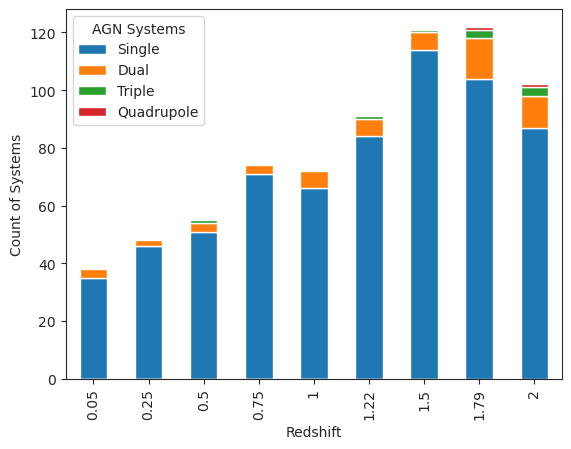
The distribution of dual and multiple AGNs detected in Romulus25 cosmological simulation.
Shining Light on the Hosts of the Nano-Hertz GravitationalWave Sources
As mentioned above, dual AGN is a phase that some SMBHs experience during their journey from galaxy-galaxy mergers to the SMBH-SMBH mergers; but not all SMBHs have had an active phase in their journey. Therefore, in the next project, I broaden my analysis to all binary SMBHs in the Romulus25 simulation. I create catalogs of merging SMBHs that emit low-frequency gravitational wave (GW) radiation and investigate the properties of their host galaxies proposing how this can be used to connect with observations of nano-Hertz GW signals and galaxy surveys. In close collaboration with Dr. Suvodip Mukherjee we show that the most dominant contribution to the background will arise from sources with high chirp masses which are likely to reside in low redshift early-type galaxies with high stellar mass, largely old stellar population, and low star formation rate, and that reside at centers of galaxy groups and manifest evidence of recent mergers. The connection shown in this work will be a guideline to explore the connections from GW observations in the nano-Hertz band and optical and infrared galaxy observations. By measuring the spatial cross-correlation between the anisotropic stochastic GW background (SGWB) with galaxies as well as a targeted search of individual galaxies for the nano-Hz GW events in the SKA era.
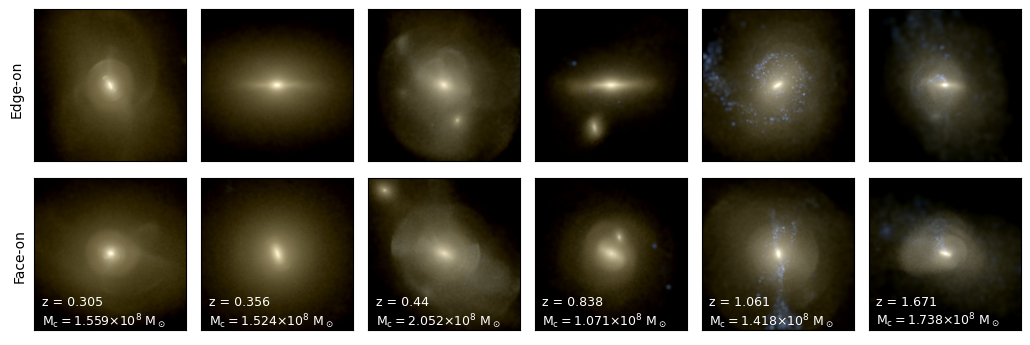
Multi-band composite image of the host galaxies for SMBBHs with chirp mass $M_c\geq 10^8$ M$_\odot$ is shown with edge-on (top) and face-on (bottom) views at redshifts they are detected.
CGM Zoom Simulation
Building on my first project, the result of my analysis of the origin and dynamic of the multiphase structure of CGM once more highlights the importance of high-resolution simulations in understanding the nature of multiphase CGM. However, with current resolution of cosmological simulation, we are only scratching the surface of understanding this phenomenon. Traditional simulations achieve spatial resolutions in the low-density galactic halo that are orders of magnitude worse than the resolution they get in the high-density disk of galaxies. This problem cannot be addressed by simply increasing the resolution everywhere in the simulation as it would be prohibitively expensive to do. In my Final project, I am developing a novel hyper-refinement model to enhance the resolution of CGM without also enhancing the resolution of the galaxies. The aim of this targeted approach is to avoid having to evolve galaxies in the simulations at very high resolution while enabling more accurate and much more realistic modeling of the spatial and dynamic structures in the CGM. To do so, I use highly efficient, massively parallel simulation code, GIZMO. I modify the GIZMO code with the physical models I developed while maintaining its efficiency and parallelization capabilities.
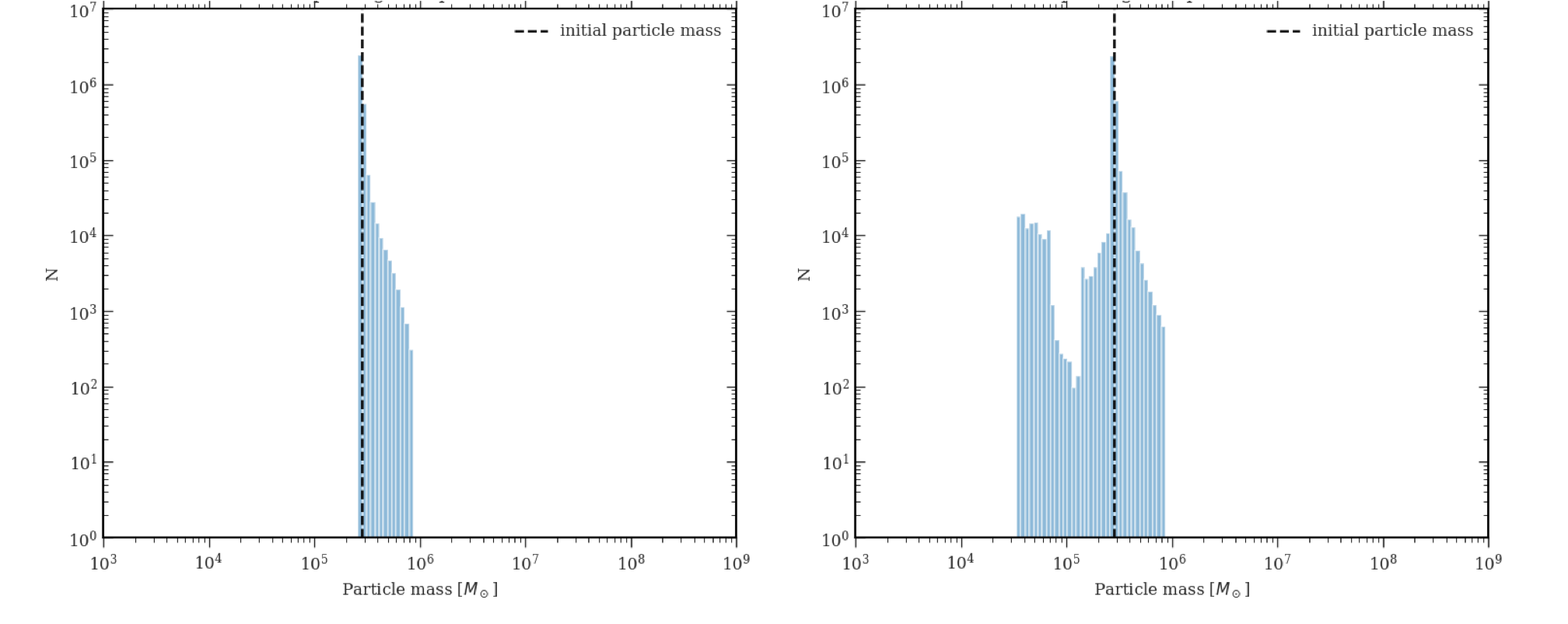
In the left image, the distribution of mass particles shows the resolution in the CGM from the original simulation run, while the right image illustrates the enhanced resolution in the CGM of the halo. The dashed black line represents the initial mass particle with which both runs began.
